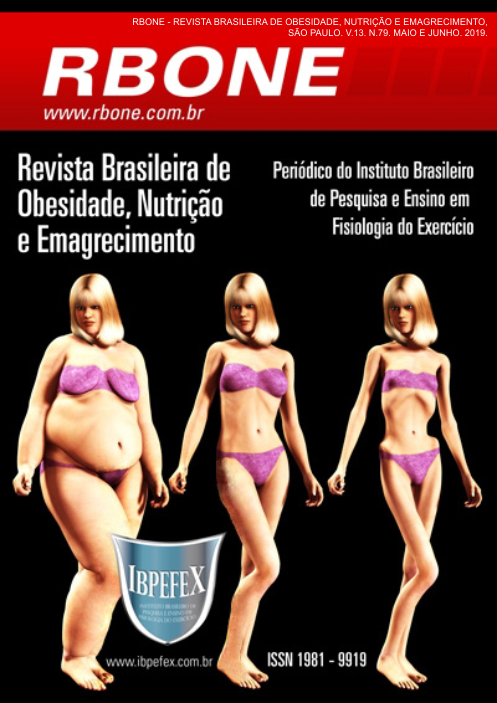Knowledge of nutritionists in phytotherapy about the hepatic function in the Phototerapic Memory: Brazilian Farmacopeia
Abstract
Introduction: the use of herbal medicines in Brazil has been growing as a therapeutic alternative, the spread of phytotherapeutic use is due to the low cost, when compared to synthetic medicines, the Phytotherapeutic Memento - Brazilian Pharmacopoeia, presents two phytotherapics that help the hepatic functioning, being Cynara scolymus L. and Ginkgo Biloba L. Thus, the present study is indispensable to verify if the ANVISA recommendations contained in the Phytotherapeutic Memento - Brazilian Pharmacopoeia are known by the Nutrition Professionals. Objective: to verify the knowledge of newly formed nutritionists about the herbal products related to liver function. Materials and Methods: the study was carried out through a form containing 09 questionnaires on herbal medicines that are related to the function of the liver with 30 nutritionists who do post-graduation Lato Sensu in Phytotherapy, with a minimum age of 22 and a maximum of 47, with a mean of 27.80 ± 5.53 with total body weight in kg, with a minimum of 42 and a maximum of 84.9, with a mean of 59.45 ± 9.28, with height in meters with a minimum of 1.52 and maximum of 1.72, with an average of 1.62 ± 0.06. Result: according to the answers indicated in each questionnaire, we noticed that most of the nutritionists who study lato sensu in phytotherapy have little knowledge about phytotherapics and their functions, about the popular name and the scientific name, as well as the dose to be prescribed. Discussion: The data in the table may represent the need to search for knowledge about herbal medicines for specific professional activities and / or the deficiency in undergraduate teaching on herbal medicines. Conclusion: it is concluded that the nutritionists who are doing lato sensu specialization in phytotherapy still do not know the phytotherapics about the liver function present in Phototerapic Memory.
References
-Ahmed, H. H.; Shousha, W. G.; El-Mezayen, H. A.; El-Toumy, S. A.; Sayed, A. H.; Ramadan, A. R. Biochemical and molecular evidences for the antitumor potential of Gingko Biloba leaves extract in rodents. Acta Biochimica Polonica. Vol. 64. Núm. 1. p. 25-33. 2017.
-Azevedo, E.; Pelicioni, M. C. F. Práticas integrativas e complementares de desafios para a educação. Trab. Educ. Saúde. Vol. 9. Núm. 3. p. 361-378. 2011.
-Brasil. Agência Nacional de Vigilância Sanitária. Formulário de Fitoterápicos da Farmacopéia Brasileira / Agência Nacional de Vigilância Sanitária. Brasília. Anvisa. 2011. 126p.
-Brasil. Agência Nacional deVigilância Sanitária. Memento Fitoterápico -Farmacopeia Brasileira. 1ª edição. Brasília. 2016.
-Brasil. Agência Nacional deVigilância Sanitária. Consolidado de normas da COFID (Versão V) -RDC, nº 26. Brasília. 13/05/2014. 2015.
-Cai, Z.; Wang, C.; Liu, P.; Shen, P.; Han, Y.; Liu, N. Ginkgo Biloba extract in combination with sorafenib is clinically safe and tolerable in advanced hepatocellular carcinoma patients. Phytomedicine. Vol. 23. p. 1295-1300. 2016.
-Conselho Federal De Nutrição (CFN). Resolução CFN nº 556. 11/04/2015.
-El-Boshy, M.; Ashshi, A.; Gaith, M.; Quaty, N.; Bokhary, T.; Aitaweel, N.; Abdlhady, M. Studies on the protective effect of the artichoke (Cynara scolymus) leaf extract against cadmium toxicity-induced oxidative stress, hepatorenal damage, and immunosuppressive and hematotological disorders in rats. Environ Sci Pollut Res. Vol. 24. p. 12372-12383. 2017.
-França, I.S.X.; Souza, J. A.; Baptista, R. S.; Brito, V. R. S. Medicina popular: benefícios e malefícios das plantas medicinais. Revista Brasileira de Enfermagem. Vol. 61. Núm. 2. p. 201-8. 2008.
-Gambardella, A. M. D.; Ferreira, C. F.; Frutuoso, M. F. P. Situação Profissional de egressos de um curso de nutrição. Rev. Nutr. Vol. 13. Núm. 1. p. 37-40. 2000.
-Marliére, L.D.P.; e colaboradores. Utilização de fitoterápicos por idosos: resultados de um inquérito domiciliar em Belo Horizonte-MG, Brasil. Rev Bras Farmacogn. Vol. 18. Num. Supl. 2008.
-Nicoletti, M. A.; Oliviera Junior, M. A.; Bertasso, C. C.; Caparossi, P. Y.; Tavares, A. P. L. Principais interações no uso de medicamentos fitoterápicos. Infarma. Vol. 19. Núm. 1. p. 32-50. 2007.
-Organização Mundial da Saúde. Práticas integrativas e complementares: Plantas medicinais e fitoterapia na atenção básica. Série A, Normas e Manuais técnicos, cadernos de atenção básica. Num. 31. Brasília-DF. 2012.
-Rosa, R. L.; Barcelos, A. L. V.; Bampi, G. Investigação do uso de plantas medicinais no tratamento de indivíduos com diabetes melito na cidade de Herval D’ Oeste-SC. Rev. Bras. Plantas Med. Vol. 14. Núm. 2. p. 306-310. 2012.
-Salem, M. B.; Kolsi, R.B. A.; Dhouibi, R.; Ksouda, K.; Charfi, S.; Yaich, M.; Hammami, S.; Sahnoun, Z.; Zeghal, K, M.; Jamoussi, K.; Affes, H. Protective effects of cynara scolymus leaves extract on metabolic disorders and oxidative stress in alloxan-diabetic rats. BMC complementary and alternative medicine. Vol. 17. Núm. 328. p. 2-19. 2017.
-Vasconcelos, F. A. G.; Calado, C. L. A. Profissão nutricionista: 70 anos de história no Brasil. Rev. Nutr. Vol. 24. Núm. 4. p. 605-617. 2011.
Authors who publish in this journal agree to the following terms:
- Authors retain the copyright and grant the journal the right of first publication, with work simultaneously licensed under the Creative Commons Attribution License BY-NC which allows the sharing of the work with acknowledgment of the authorship of the work and initial publication in this journal.
- Authors are authorized to enter into additional contracts separately for non-exclusive distribution of the version of the work published in this journal (eg, publishing in institutional repository or book chapter), with acknowledgment of authorship and initial publication in this journal.
- Authors are allowed and encouraged to post and distribute their work online (eg, in institutional repositories or on their personal page) at any point before or during the editorial process, as this can bring about productive change as well as increase impact and impact. citation of published work (See The Effect of Free Access).






